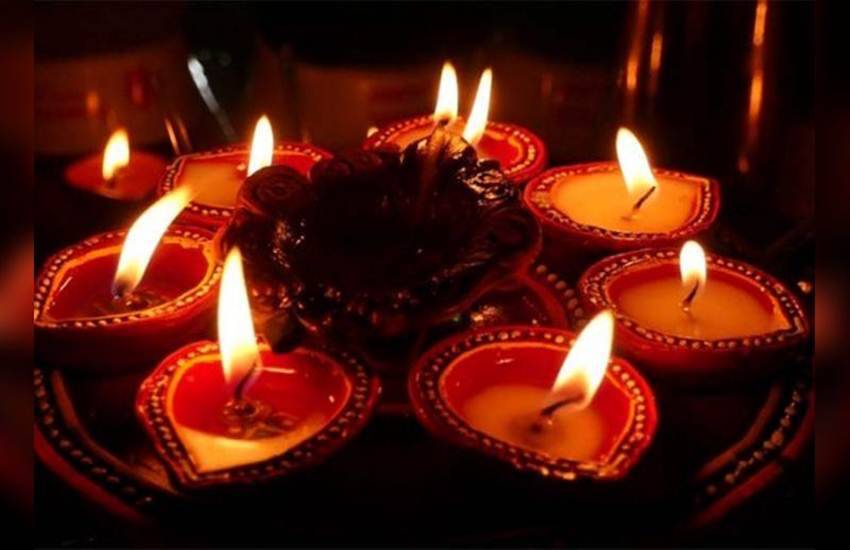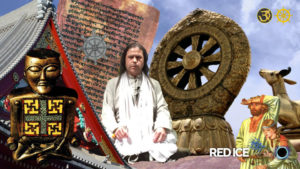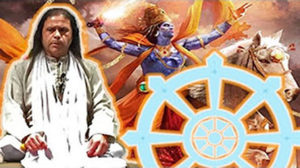One of the most terrible tragedies experienced by so many millions of people today has been the debilitating problem of addictions. Whether we are speaking of drugs, alcohol, cigarettes, video games, raging emotions or pornography, addictions have brought about a degree of suffering to the lives of millions that is unimaginable. In this moving video, Sri Dharma Pravartaka Acharya addresses a viewer’s question on how to overcome addictions with tremendous compassion, directness and wise insight. The root causes of addiction are ultimately a spiritual deficiency. The solution is, likewise, a spiritual answer.
Tag Archives: dharma nation
Overcoming Addictions Spiritually
All-Pervading Vishnu
One of the most important features of God’s nature is that He pervades all of spiritual and material reality. In this livestream discourse and Q&A session, Sri Dharma Pravartaka Acharya gives us a glipse of the all-pervasive nature of Vishnu. “Śrī Pippalāyana said: Nārāyaṇa is the cause of the creation, maintenance and destruction of this universe, yet He has no prior cause. He pervades the various states of wakefulness, dreaming and unconscious deep sleep and also exists beyond them. By entering the body of every living being as the Supersoul, He enlivens the body, senses, life airs and mental activities, and thus all the subtle and gross organs of the body begin their functions. My dear King, know that Nārāyaṇa to be the Supreme.” (Srimad Bhagavatam, 11.3.35)
Practicing Gratitude in Spiritual Life
One of the most important principles that the religious tradition of Sanatana Dharma teaches us is that we are at all times surrounded by the blessings and grace of God. Despite the fact that God is always bestowing His blessings upon us, many of us struggle to be aware of God’s tremendous gifts in our lives. In this exclusive talk that was delivered February 27, 2021 on the ISDS Discord server, Sri Dharma Pravartaka Acharya shares with us the nature of God’s blessings, as well as the importance of cultivating a deeper sense of appreciation, gratitude and thanksgiving in our lives. If you wish to receive God’s blessings, then be a blessing in the lives of others.
The Transcendental Nature of God
The nature of God is one of the most important philosophical/theological topics to be understood. According to the Vedic scriptures and the tradition of Sanatana Dharma, God transcends all materiality, illusion, faults and defects. God is never – ever – subject to illusion. In this livestream talk, Sri Dharma Prvartaka Acharya discusses the transcendental nature of God by examining two verses from the Srimad Bhagavatam.
śrī-rājovāca
nārāyaṇābhidhānasya
brahmaṇaḥ paramātmanaḥ
niṣṭhām arhatha no vaktuṁ
yūyaṁ hi brahma-vittamāḥ
“King Nimi inquired: Please explain to me the transcendental situation of the Supreme Lord, Nārāyaṇa, who is Himself the Absolute Truth and the Supersoul of everyone. You can explain this to me, because you are all most expert in transcendental knowledge. (Srimad Bhagavatam, 11.3.34)
śrī-pippalāyana uvāca
sthity-udbhava-pralaya-hetur ahetur asya
yat svapna-jāgara-suṣuptiṣu sad bahiś ca
dehendriyāsu-hṛdayāni caranti yena
sañjīvitāni tad avehi paraṁ narendra
“Śrī Pippalāyana said: Nārāyaṇa is the cause of the creation, maintenance and destruction of this universe, yet He has no prior cause. He pervades the various states of wakefulness, dreaming and unconscious deep sleep and also exists beyond them. By entering the body of every living being as the Supersoul, He enlivens the body, senses, life airs and mental activities, and thus all the subtle and gross organs of the body begin their functions. My dear King, know that Nārāyaṇa to be the Supreme.” (Srimad Bhagavatam, 11.3.35)
Bhakti is the Superior Process – Narada Bhakti Sutras, Session Twelve
In this continuation of his now legendary Narada Bhakti Sutras class, Sri Dharma Pravartaka Acharya explains in great depth the relationship between philosophy and direct spiritual experience; the subtleties of spiritual epistemology; the differences between pure devotion versus mixed devotion; and the clear superiority of the path of bhakti for the purpose of knowing God, compared to every other spiritual path and form of Yoga.
Narayana: The Source of All Reality
The Supreme Absolute of the Vedic tradition is known by the divine name Sriman Narayana. Narayana is the source of all reality, transcends all materiality, is never subject to illusion, and is the utmost highest of all beings. In this powerful livestream event, Sri Dharma Pravartaka Acharya explains to us two verses from the beautiful Vedic scripture known as the Sri Vishnu Sahasranama that reveal what is the true nature of God.
“The sages, Pitaras (departed ancestors), gods, the mahābhūtas (great elements), and their effects, the moving and the non-moving objects which comprise the entire universe – all have been projected from Nārāyaṇa.” (Sri Vishnu Sahasranama, Uttara Bhāgaḥ, 18)
“Vishnu is the unique and unparalleled deity in that He pervades the great elements of different kinds and the three worlds of existence. He is the Super-soul of all beings and their protector. He transcends all of them and is not touched by their defects. Thus He enjoys supreme bliss.” (Sri Vishnu Sahasranama, Uttara Bhāgaḥ, 20)
The Path of Joy
Every living being is seeking true joy. True and lasting joy is nothing less than our spiritual birthright. Despite this fact, so many people feel deprived of the joy that they so earnestly seek and desire. In this special livestream discourse and Q&A session, Sri Dharma Pravartaka Acharya outlines the path of joy for us. In knowing the Infinite, you can know joy!
“Bhrigu practiced meditation and learned that joy is Brahman. For from joy all beings are born, by joy they are sustained, being born, and into joy they enter after death. This is the wisdom which Bhrigu, taught by Varuna, attained within his heart. He who attains this wisdom wins glory, grows prosperous, enjoys health and fame.” (Taittiriya Upanishad, 3.6.1)
“The Infinite is the source of joy. There is no joy in the finite. Only in the Infinite is there joy. Ask to know of the Infinite.” (Chandogya Upanishad, 7.23.1)
Living Dharma- Weekly Livestream
From the Introduction to “Living Dharma”: “The contents of ‘Living Dharma: The Teachings of Sri Dharma Pravartaka Acharya’ cover a wide range of topics, both philosophical and practical. This great diversity of topics is very much by design, since there is no aspect of the human experience that Dharma does not touch upon directly and conclusively. Thus, while each one of these short wisdom sayings will provide a deeply spiritual vision to the reader, some of them also comment upon such seemingly “secular” aspects of human thought as psychology, politics, economics, social science, culture, aesthetics and health. The only way to truly incorporate the teachings of Sanatana Dharma into your life is to practice Dharma in every single aspect of your life, without exception. This is exactly what ‘Living Dharma’ was created to help you do.”
An Offering to God – Puja Introduction
In the wake of Dīpāvali, the act of Puja is a phenomena that is likely be fresh in the minds of many, devotee or spiritual seeker alike. As custom, on the night of Dīpāvali, individuals around the world will light ghee wick laps as an offering to Lord Sri Rāma (the incarnation of God), in celebration of his return to His kingdom of Ayodhya as the rightful king.

One of the most effective means of devotional meditation is known as Puja. This post is intended as an introductory guide for anyone interested in performing their own Puja at home.
Puja involves the direct meditative worship of God through the making of various symbolic offerings to God with devotion. Usually conducted before a temple altar, or at home with your own personal altar, the performance of Puja is an important devotional activity that can and ideally should be conducted as part of ones daily Sādhanā.
The ultimate goal of Sanatana Dharma (the Eternal Natural Way) is to re-establish our innate relationship with God. Through the re-establishment of our connection to God, a devotee is able to overcome trauma, rid themselves of the bonds of material attachment, and otherwise grow spiritually as an individual. We do this by cultivating a devotional consciousness towards the Supreme.
Puja is not merely a ritual or ceremony however. It is not “ritualism”. It is an active act of meditation, in which a dharmi is systematically transforming their consciousness into a mode of natural surrender of the individual self to the Supreme Self that is God. Through the process of Puja meditation, a devotee offers various pure substances to the murti, or divine image, of God. With each item that a dharmi offers, they are meditating on the fact that they are, in actuality, offering their inner being at the lotus-feet of the Divine.
The performance of Puja can be a profound and humbling experience, and is thus a recommended and beneficial practice to take up at home as part of ones practice.
In order to perform a Puja ceremony at home, ideally one should have an established home altar. This altar can be as simple as a small table or shelf, or as elaborate as putting aside an entire room or a section of a room just for the purpose of performing sadhana. The size and scope of ones altar is secondary to the quality of the practice itself. The most important thing to keep in mind is that, more important than how large your altar might be, is how much awareness and sincerity you bring to your puja practice.
As stated in the Bhagavad Gita (9:26), Sri Krishna Him self explains:
“If one offers Me with love and devotion a leaf, a flower, fruit or water, I will accept it.” The quality of devotion with which we offer anything to God is much more important than the quantitative value of what we offer.

There are several items that a dharmi should ideally have if they are to perform puja. At a minimum, one should have access to incense and an incense holder, a means of lighting them, such as a lighter or matches, a hand bell to ring, and a ghee-wick lamp (which subsequently require wicks and ghee to utilize fully.) The uses for these will be layed out shortly.
You must be bathed and clean before performing puja. This is very important.
As one of the Niyamas, or prescriptions, to which a dharmi should strive to adhere to, Shaucha, or purity, applies to physical cleanliness as much as it does to purity of mind.
Purity consists of both scrupulous external hygiene, and internal cleanliness of mind. The former is achieved by bathing, brushing one’s teeth etc, every day without fail. The latter is accomplished by allowing only good, pure, positive and spiritual thoughts to flourish in our minds, and by conversely not allowing the opposite (evil, impure, negative and materialistic thoughts) to dominate our minds.
As a result of this, when we perform Puja, a dharmi must strive to ensure he is clean of body and mind before commencing.
To start the act of Puja, a dharmi should situate themselves before their altar. First, one should center themselves. This is best done by closing your eyes and taking a few normal breaths with awareness, allowing yourself to be at peace and open to God’s grace.
Next, opening your eyes, place your hands together in ‘namaste’ gesture and offer your obeisances to the murti, reciting “Jaya Sriman Narayana” (Victory to Sri Sri Lakshmi and Narayana).
Light a stick of incense. Now begin ringing the bell rhythmically with your left hand. Gently wave the incense stick in your right hand in a clockwise circular motion – three times to the face of the image, three times to the belly, three times to the feet, and finally four times around the entire image. Then place the incense stick in a safe holder. The offered incense is now prasada, or the sanctified grace of God. Smelling its aroma is spiritually beneficial because its scent was first accepted by God.
Next, light the ghee wick lamp. Offer the ghee wick lamp with your right hand, ringing the bell in your left hand in the same manner and with the same numbers as the incense was previously offered (three times to the face, belly and feet, then four times around the entire image). When you are done, quickly pass your hands over the flame of the ghee wick lamp and place your hands to your forehead for a blessing. The flame of the ghee-wick, too, is now sanctified prasada. Thus, seeing the flame and smelling its aroma will be spiritually beneficial.
You may then offer other items in a similar manner to how you offered the incense and ghee-wick lamp. Other items that you can offer include: a flower, water, or some simple food such as almonds or raisins (which are afterwards eaten as a sacrament, or “prasada”).
After the puja is over, you may again place your hands in the ‘namaste’ gesture and offer your obeisances to the altar. Offering obeisances is performed by placing your forehead to the ground while having the top of your head facing the deity. Please then recite the following mantras.
aum ajnana timirandhasya
jnananjana shalakaya
chakshur unmilitam yena
tasmai sri guruve namaha
“I offer my respectful obeisances to my spiritual teacher, who has opened my eyes, which were blinded by the darkness of ignorance, with the torchlight of knowledge.”
he krishna karuna sindho
dina bandho jagat pate
gopesha gopika kanta
radha kanta namo’stu te
“Oh Krishna, ocean of mercy, You are the friend of the distressed and the source of creation. You are the master of the cowherdmen and the lover of the gopis, especially Radha. I offer my respectful obeisances unto You.”
tapta kanchana gaurangi
radhe vrindavaneshvari
vrishabhanu sute devi
pranamami hari priye
“I offer my respects to Radha, whose bodily complexion is fair and who is the Queen of Vrindavana. You are the daughter of King Vrishabhanu, and are very dear to Lord Krishna.”
Sriman Narayana Charanau Sharanam Prapadye
Srimate Narayanaaya Namah
“I seek refuge at the feet of Sriman Narayana. My salutations to Sriman Narayana.”
Having completed the puja, this would now be an ideal time to now perform your daily meditation practice in front of your altar, smelling the sweet aroma of the incense and ghee-wick.
Linked below is a video by Sri Dharma Pravartaka Acharya performing a puja before the Lakshmi-Narayana murtis at the ISDS temple in Nebraska.
Sri Rāma: Return of the King
November 4th marks the very important Vedic holy day of Dīpāvali. This sacred holy day marks the celebration of the triumph of good over evil. It also specifically celebrates the day in history when Lord Sri Rāma (the incarnation of God) returned to His kingdom of Ayodhya as the rightful king. Thus, Dīpāvali is also a celebration of the return of the divine king to His people. In this livestream event, Sri Dharma Pravartaka Acharya will explain the significance of Lord Sri Rāma and the significance of the return of the king in our times.
“Rāma, son of Rajaṛṣi Daśaratha, united with the most charming princess, shone like Viṣṇu, Lord of the gods, in the company of Lakṣmī.” (Rāmāyaṇa, 1.77.32)
“You are Brahman, the imperishable, the Truth abiding in the middle as well as at the end of the universe. You are the supreme righteousness of people, whose powers go everywhere. You are the four-armed.” (Rāmāyaṇa, 6.117.14)
“Rāma is the Supreme Lord of all worlds, a lion among kings. Having pained Him it is very difficult for you to sustain your life after offending Him to this extent. O king of demons, even devas, daityas, gandharvas, vidyādharas, nāgas, and yakṣas are incompetent to face Rāma the lord of the three worlds in wars. Even the self-born, four-faced Brahmā, the three-eyed Śiva who destroyed Tripura, Mahendra, the king of suras do not have the power to save one whom Rāma decides to kill”. (Rāmāyaṇa, 5.51.43-45)
“I now recognize You to be the Supreme Person, duly dispatched here in disguise by the rulers of the gods for the destruction of Rāvaṇa, O gentle one!” (Rāmāyaṇa, 6.119.18)
Understanding the Meaning of AUM
AUM (sometimes misspelled “om”) is neither a New Age invention, nor an incomprehensible mystery, but rather represents the very sound representation of the omnipresence of God Himself. In this livestream discourse, Sri Dharma Pravartaka Acharya provides an exhaustive and conclusive explanation of the meaning of the mantra AUM as revealed in the Vedic scriptures.
“By virtue of a little understanding of Aum a person returns to earth after death. By virtue of a greater understanding he attains to the celestial sphere. By virtue of a complete understanding he learns what is known only to the seers (rishis). The sage, with the help of Aum, reaches Brahman, the fearless, the undecaying, the immortal!” (Prashna Upanishad, 5.6-7)
“Affix to the Upanishad, which is the incomparable bow, the sharp arrow of devotional worship. Then, with mind absorbed and heart melted in love, draw the arrow and hit the mark – the imperishable Brahman (God). Aum is the bow, the arrow is the individual being, and Brahman is the target. With a tranquil heart, take aim. Lose the arrow of your self in Him, even as the arrow is lost in the target.” (Mundaka Upanishad, 2:2:3-4)
“Within the lotus of the heart he dwells, where, like the spokes of a wheel in its hub, the nerves meet. Meditate on him as Aum. Easily may you cross the sea of darkness.” (Mundaka Upanishad, 2:2:6)
Knowing the Eternal
The Eternal, God, can be gained and known by the sincere spiritual seeker. In this special livestream event, Sri Dharma Pravartaka Acharya explores the teachings of the Mundaka Upanishad with us, and reveals precisely how we can know the Eternal! “Let a man devoted to spiritual life examine carefully the ephemeral nature of such enjoyment, whether here or hereafter, as may be won by good works, and so realize that it is not by works that one gains the Eternal. Let him give no thought to transient things, but, absorbed in meditation, let him renounce the world. If he would know the Eternal, let him humbly approach a guru devoted to Brahman and well-versed in the scriptures.” (Mundaka Upanishad, 1.2.12)
The Highest Path of Yoga
The integral path of Yoga is both a profoundly coherent philosophical world-view, as well as the most practical system for achieving self-realization and God-consciousness available in the world. In this livestream discourse, Sri Dharma Pravartaka Acharya shares with us the most immediate benefits to be derived from practicing the full Yoga system with daily dedication.
“Only when manas (mind) with thoughts and the five senses stand still, and when buddhi (intellect, power to reason, wisdom faculty) does not waver, that they call the highest path. That is what one calls Yoga, the stillness of the senses, concentration of the mind. It is not thoughtless, heedless sluggishness. Yoga is creation and dissolution.” (Katha Upanishad, 2.6.10-11)
“Pleasure and pain results from contact of soul, sense, mind and object. Non-origination of that follows when the mind becomes steady in the soul. After this, there is non-existence of pain in the embodied soul. This is that Yoga.” (Vaiśeṣika Sūtra, 5.2.15-5.2.16)
Acharya – Dharma, Natural Law: A Remedy to the Spiritual Crisis in the West?
Acharya interviewed on Dharma on Red Ice Radio.
Sri Dharma Pravartaka Acharya is the author of The Dharma Manifesto and the leader of the Dharma Nation movement. In this amazing interview, he discusses many topics, including: ancient forms of spirituality; Natural Law and Natural Order; the deep connections between pre-Christian European spirituality and Sanatana Dharma; the evils of Abrahamism; contemporary politics; defeating the New World Order; the Golden Age; and many other topics. You don’t want to miss this interview!
Watch ‘Acharya – Dharma, Natural Law: A Remedy to the Spiritual Crisis in the West?’
Interview with a Vedic Guru
Sri Acharyaji interviewed about his book ‘The Dharma Manifesto‘ on the Survive the Jive show
In this fascinating interview, Acharya is asked about the contemporary political scene in Europe and America; the rise of Nationalism; the Trump presidency; the ancient connections between Sanatana Dharma and European Paganism; Natural Law; and many other topics.
Watch ‘Interview with a Vedic Guru‘



